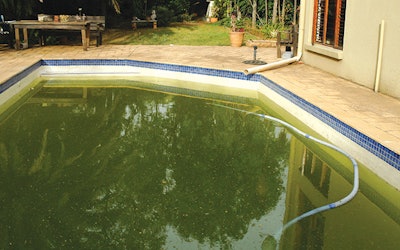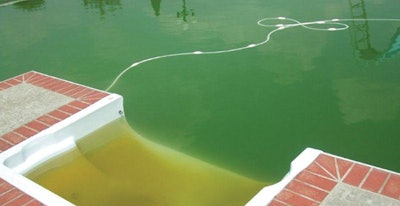
Chemical manufacturers report that fighting algae, in all its many forms, remains the most common source of helpline calls from both homeowners and professionals.
As those who carry on this battle can attest, the campaign is waged using various strategies that work in different ways. There is no one-size-fits all algae treatment, which is why the industry is replete with different algaecides (algae killers) and algistats (algae preventers).
There are tens of thousands of algae types, and there are regional aspects of algae as well — strongholds of one type or another. And there are numerous ways algae finds its way into pool and spa water, including wind, bathers, runoff from rain and more.
Experienced service techs often have firm convictions about what works and what doesn't, and those ideas are often contradictory, which is likely due to the variety of characteristics that can exist within a particular category of algae.
READY TO RUMBLE
Although there are multiple ways to attack and kill algae, the most common measures, the soldiers in the front rank, are chlorine and bromine.
"Chlorine and bromine are great algaecides," says Ellen Meyer, product safety and government relations manager for Innovative Water Care. "If you're not killing algae with your regular chlorine residual, you're probably not maintaining enough of an HOCl residual. That's by far the most important factor. You have to maintain a residual in all parts of the pool at all times."
RELATED: The Science of Starving Algae
"That's why you want balanced water and an adequate level of stabilizer so that you are able to maintain an appropriate chlorine residual," adds Zach Hansen, manager of new product development for BioLab. "When you don't maintain a proper residual, that's when the pool will become susceptible to algae blooms."
While chlorine residuals maintained at 1-4 ppm HOCl, per the EPA standard, are generally considered to be effective at algae control (though there are many who believe that standard should be adjusted), there are key factors that influence the amount of free available chlorine.
As is widely taught throughout the industry, pH influences sanitizer equilibriums as do cyanuric acid levels, which are necessary to maintain a residual but do reduce the percentage of available HOCl as levels CYA rise. (The relationship between chlorine and CYA is the subject of ongoing debate within the industry, with some voices advocating a system where chlorine levels are determined by the CYA concentration.)
"Even with all the variables," Meyer says, "we can be certain that the more cyanuric acid you have in the water, the less HOCl, which can have a direct impact on whether or not algae becomes a problem."
DEAD ZONES
Beyond maintaining an adequate sanitizer residual, both Meyer and Hansen emphasize that sanitizers, algaecides and algistats can only be effective if they reach the entire pool.
"While maintaining a residual is number one," Meyer says, "a subset of number one is the circulation system. If it's not working properly, you're not going to be getting that residual to all areas of the pool at all times."
Hansen agrees. "Yes, it's very common to see algae take hold in areas of the pool that don't have adequate circulation, or dead spots. That might be behind ladders, in corners or on steps and benches. Pools are always being exposed to an onslaught of possible sources of algae such as wind debris, rain and the surrounding environment depending on the type of vegetation located around the pool. It seeds within the pool in the dead spots and then spreads. It colonizes and forms an extracellular matrix [biofilm] that shields the algae from the broader water and all the chemicals of the pool."
Filtration is another layer of algae defense doing much of the heavy lifting by physically removing it, often with the aid of flocculants. The same is largely true of skimming action, which removes algae entering the pool via the surface. Regular brushing of the pool's surface is also extremely important.
RELATED: Got Algae?
"From a maintenance practice perspective, routine brushing also helps ensure you're physically disrupting any accumulation on the pool's interior surface, even before you can see it," Hansen says. "You're dispersing the algae colonies into the pool where they're exposed to the chemicals. The physical cleaning and the chemistry work together. If you only do one or the other, it won't nearly be as effective."

KNOW THY ENEMY
While those basic maintenance measures are important for all chemically treated pools and spas, it's equally important to take into account the diversity of algae species.
"It's easy to paint algae with broad strokes that don't take into account the variety and diversity," Hansen says. "We tend to think in terms of green algae, black algae or mustard algae. It's been a useful way to segment the different types to help customers understand the characteristics of each. In each of those categories, however, there are literally thousands of algae species."
"Take green algae, for example," Meyer explains. "The most common type is Chlorella, but there are several types of Chlorella. And for yellow or mustard algae, again there's a variety of organisms that fall into that category, such as Pleurochloris."
The varying kill rates are why manufacturers recommend a layered approach in combating algae. "You want to approach it from different angles so the different aspects of chemistry work together," Hansen says. "So you have chlorine as a baseline, but then we've always taught that you should also use a maintenance algaecide as well. If you're treating with a quat, poly-quat or a sequestered copper/metal algaecide, you're attacking it on multiple fronts. Combined with chlorine and regular brushing, your odds of avoiding an algae problem are greatly increased."
In considering specific ways to kill different types of algae, Meyer explains that there's a relationship between rate of growth and resistance to chemical treatment.
"In general, it is easier to kill actively growing cells than cells that are slower growing. For example, green algae grow very quickly, but it's also easier to kill because it has a lot going on chemically," she says. "It's more susceptible to toxins in its environment because a lot of nutrients and waste products are going in and out of the cellular membranes. Mustard algae is slower growing, so it's harder to kill. It doesn't have as much nutrient and waste material moving across its cellular membrane."
FLYING COLORS
Black is widely considered the most difficult algae to eliminate, with some professionals claiming that once it finds its way into a pool, it can never be completely eradicated.
"Black algae is one of the most distinct organisms that we label algae," Meyer says. "There are several species and one of the most common is Phormidium. It's the hardest to kill because it's very slow growing by comparison and it has layers of protection. There's the slime layer that's part of the biofilm, which they all have and which protects it. Black algae also has a calcium carbonate crust that makes it even harder to kill.
RELATED: ABCs of Algae
"Because black algae has that calcium carbonate layer," she continues, "lowering the pH can help treat it. That is why you see people using trichlor for this application, but only in white plaster pools. If you place trichlor directly on black algae, the low pH helps get through that crust and then the chlorine is there to kill the algae. Obviously you wouldn't want to do that in a pool where you don't want to bleach the surface, but in a white plaster pool it works great."
For his part, Hansen sees yellow algae as the toughest.
"Mustard algae, for example, is traditionally considered the most difficult to kill because it can show some resistance to chlorine. What we've seen is that some of the species in that category have double-membrane systems. You could think of it as a mother cell that has daughter cells inside it. So in terms of treatment, you have these multiple membranes you have to work through to kill it. Additionally, the pigment that gives its yellow color can act as a reducing agent that actually works to neutralize the chlorine. So if you have a problem with mustard algae, you want to maintain a chlorine residual, brush the walls and treat it with an appropriate algaecide that targets this particular type of algae."
Some algae species aren't really algae at all, such as the enigmatic pink algae. "Pink algae is actually a mold, Paecilomyces, which is a whole different beast altogether," Meyer says. "We used to see it only in PHMB pools, but now we are seeing it in chlorinated pools as well. It can be really difficult to treat. This newer version grows in white, massive blooms in all sorts of different shapes. It's very difficult to treat, even with high levels of chlorine and various algaecides. We have seen a regional trend where we first started seeing it in the Midwest and then it spread into other areas such as western New York. It's just a hypothesis, but some crops are treated with Phormidium, so we suspect that may be the reason we see it in certain areas."
WEAPONS IN THE ALGAE WAR
Beyond chlorine and bromine and PHMB (biguanide), all EPA-registered sanitizers and algaestats, there are the tireless algae combatants quaternary ammonium (quat), metals, ozone and UV, among others.
Ozone in particular is gaining adherents due to its versatile ability to carry out other sanitizing roles. Proponents of ozone point to research, largely in municipal water treatment settings, that indicate ozone, often combined with other treatment measures, is extremely effective in removing algae.
RELATED: Cleaning Up a Summer Swamp
In swimming pools, ozone, UV and metal ionizers provide an effective combination with chlorine, which provides a constant residual.
Those well-known methods have been joined in recent years by growing acceptance of treating algae with sodium tetra borate, which is an EPA-registered algistat. Borate has gained widespread acceptance among service techs and homeowners alike, with some manufacturers and other chemistry authorities claiming it reduces the amount of chlorine needed to effectively prevent algae.
"In terms of other treatments, sodium tetraborate is registered with EPA and can be sold as an algistat," Hansen says. "It has gone through the gauntlet of the EPA registration process that evaluates performance and safety, where it's been shown to help control algae. We have customers who have had a lot of success with it."
Removing nutrient sources, particularly phosphates, is yet another strategy in preventing algae that has gained popularity in recent years as a way to "starve" algae.
"I believe if phosphates are making a difference, there are other underlying issues that need to be addressed," Meyer says. "If you're not maintaining a sanitizer residual due to poor circulation, for example, then starving the algae could be a backup plan. Since dead algae don't eat, your primary objective should be to maintain a sanitizer residual in all parts of the pool at all times to prevent the growth of algae. The use of phosphate remover along with a residual sanitizer and good pool circulation can all help ensure an algae-free pool."












































